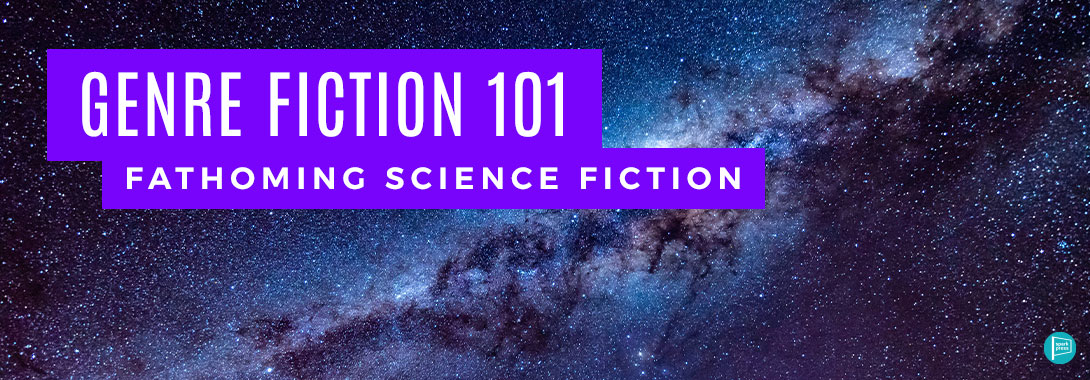
In this multi-post series, we hope to answer some of your questions about different genre fiction. Throughout GENRE FICTION 101, you’ll learn about different genres and their place in the publishing world. We’ll discuss popularity, profits, typical tropes, controversies, and more. Read the intro installment here.
What is Science Fiction?
Science fiction, or Sci-Fi, is home to many who take Stephen Hawking’s advice to “Remember to look up at the stars and not down at your feet.” This genre explores the scientific unknown, from time and space travel, to extraterrestrial life, artificial intelligence, and parallel dimensions.
Though this genre is often fantastical, but it is not fantasy. Science fiction sets itself apart from the fantasy genre because it is rooted in the reality of scientific principles. You won’t see magic wands here, but speculative writing based on reality. David Hartwell described this balance: “Science fiction’s appeal lies in combination of the rational, the believable, with the miraculous. It is an appeal to the sense of wonder.” Sci-fi books capture the imagination of those who ponder the heights to which advanced science and technology can climb.
Origination
Teenaged Mary Shelley wrote Frankenstein in 1818, and she’s widely attributed as the inventor of science fiction. From there, science fiction slowly gained speed as a genre with Twenty Thousand Leagues Under the Sea by Jules Verne, Aldous Huxley’s Brave New World, and Isaac Asimov’s classic I, Robot.
Amongst these early pioneers was H.G. Wells, who imagined huge scientific leaps in books like The Island of Doctor Moreau, The Invisible Man, and The War of the Worlds. He explored nearly every corner that science fiction has to offer, paving the way for future sci-fi writers by writing about aliens, artificial intelligence, and time travel. He also predicted inventions that hadn’t come into the world yet, like air and space travel and nuclear weapons.
Sub-Genres of Sci-Fi
Because science fiction writers never shy away from reaching for the stars, there are no shortage of sub-genres. Here are the most popular:
Alternative History
Not all sci-fi takes place in the future! For these books, the stories explore what might have happened if large events in history played out a different way. The Man in the High Castle by Philip K. Dick, for instance, takes place in a universe where the Axis won in WWII.
Dystopian Fiction
These books center around societies that are problematic and/or broken down in some way, whether it’s caused by government policies or systematic oppression. This is one of the most popular sub-genres out there, with huge hits like The Hunger Games by Suzanne Collins or Divergent by Veronica Roth.
Space Opera
These stories take place in outer-space, and have elements of adventure, romance, and drama. Think The Hitchhiker’s Guide to the Galaxy by Douglas Adams and Ender’s Game by Orson Scott Card.
Space Western
We bet that most critics would agree that this is by far the silliest sub-genre of sci-fi, but space Western stories are well-beloved. These books have all the old-school charm of a frontier tale, but with a futuristic twist. Check out Frontier Earth by Bruce Boxleitner. Or, if you’re looking for some great art as well, try graphic novel Daisy Kutter: The Last Train by Kazu Kibuishi.
Cyberpunk
In these books, you’ll see characters using high tech in a broken-down society. Or, as BookRiot says, “Fancy advanced technology plus dystopian elements equals cyberpunk.”
Some popular choices in this category are Altered Carbon by Richard K. Morgan and Nueromancer by William Gibson.
Steampunk
Another sub-genre mash-up, steampunk combines the past and the future. It’s sort of like alternative history, but with a specific twist. Steampunk takes the steam-powered technology that boomed in the Victorian era and brings it to new heights with possibilities that advance reality. If you want to try reading steampunk, try The Anubis Gates by Tim Powers or Boneshaker by Cherie Priest.
Where is Science Fiction Going?
Science fiction’s popularity has grown leaps and bounds since Mary Shelley wrote about Dr. Frankenstein’s crazed science experiment, and will continue to grow in every direction. In Lester del Rey’s words, “there are no easily delineated limits to science fiction.” It’s impossible to quantify the bounds of the imagination, especially since scientific advances are always ongoing. As long as technology continues to advance, so will writers’ ability to dream stories that are out of this world.

Leave A Comment